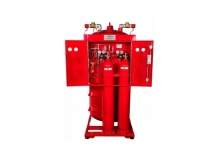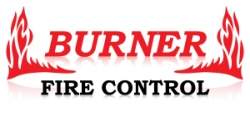
Burner Fire Control manufactures a wide range of fire suppression equipment, which is suitable for suppressing fires in hazardous environments.
Dry chemical powder skid units
Burner’s dry chemical powder skid units have been utilised in offshore and land applications for over four decades. Standard skid capacities are available in 500lb, 1,000lb, 1,500lb and 2,500lb and can be completed with a standard skid, pipe or trailer installation. DCP units can be customised according the client’s requirements and all systems can be pre-pressurised for instant discharge with no pressurisation stand-by or dry chemical packing. Systems can accommodate single person operation or be configured for automatic discharge. Hose-reel auto actuated systems can by designed to client specification. Dry chemical powder units are suitable for offshore oil & gas facilities, LNG tankers, marine vessels and fuel storage locations.
Aqueous film-forming foam (AFFF) fire suppression systems
AFFF foam fire suppression units are self-contained and as they do not require an outside pumping system or water source, they effectively provide a rapid response on Class B fires involving hydrocarbon fuels and flammable liquids. The foam coats and cools the pool of liquid and acts a vapour suppressant to aid in preventing re-ignition of the hazard area. AFF systems are suitable for offshore oil & gas facilities, as well as oil and LNG tankers.
Twin-agent dry chemical powder and foam skid units
Twin-agent dry chemical powder and AFFF systems combine the powerful DCP fire-fighting agent with the AFFF flame suppressant. The dual-agent application is the most effective tool for lessening extreme risks with multiple hazards such as flammable liquids, gases, and hydrocarbons. Twin-agent skid units are suitable for offshore oil & gas facilities, marine vessels, aviation, heliports and LNG tankers.
Portable and semi-portable compressed air foam system (CAFS) units
Compressed air foam systems (CAFS) are self-contained stored-energy fire suppression units that can inject compressed air into the foam solution to generate a powerful fire attacking and suppression foam. This type of foam has a tighter denser bubble structure than pure water or standard foam solutions. This bubble structure allows the foam to adhere to vertical and horizontal surfaces, as well as penetrate fires deeper before the bubbles are broken down, allowing the latent water to be more effective.
Stored-energy CAFS refers to the method used to dispense the compressed air foam. Instead of using pressurised air generated by an air compressor, Burner’s systems use compressed air or nitrogen, making them ‘self-contained’ systems and no external resources are required to actuate the system. The units can also be quickly recharged to respond to additional hazards.
Water curtain rig cooling on offshore facilities
Heat and thermal radiation can become significant during high-rate well test operations on mobile offshore drilling units (MODUs) and other offshore facilities. Burner’s first priority as an organisation is the protection of personnel, health, productivity and clients assets. API provides guidelines for recommended practices regarding heat radiation thresholds.
The company not only aims to meet compliance with these practices, but exceed these standards through decades of rig-cooling project experience with the world’s leading testing companies and operators.

